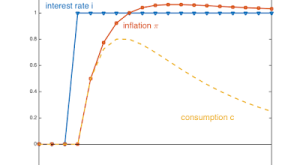In the JEEA 14(4) (August 2016) Klaus Adam and Junyi Zhu argue that unexpected price-level movements generate sizable wealth redistribution in the Euro Area (EA) … The EA as a whole is a net loser of unexpected price-level decreases, with Italy, Greece, Portugal, and Spain losing most in per capita terms, and Belgium and Malta being net winners. Governments are net losers of deflation, while the household (HH) sector is a net winner … HHs in Belgium, Ireland, Malta, and Germany experience...
Read More »Central Bank Independence, Old-Fashioned?
The Economist speculates that central bank independence might be on its way out. The article suggests that motives for independence (i.e., Sargent/Wallace or Barro/Gordon type arguments) might be less relevant given the environment of low inflation and interest rates. See also my earlier, related blog post.
Read More »Great Graphic: The Decline in Durable Goods Prices
Summary: Service prices are rising, while goods prices have steadily fallen. Non-durable goods prices are stabilizing, while durable goods prices are still falling. The decline in durable goods prices is an important economic development. The rust line is service prices. They are steadily increasing. No deflation or disinflation here. Think about rent, medical services, education, and entertainment. The three...
Read More »Blades Whirring Over Japan?
Japanese central bankers are not in an enviable position. The year-over-year growth rate of the country’s core consumer price index was -0.4 percent in May, marking the third consecutive monthly decline—and this after three years of Abenomics. Brexit certainly hasn’t helped. The yen has strengthened from ¥121 to the dollar in February 2016 to ¥105 in late July. That’s had the effect of reducing import prices, but it has also put downward pressure on inflation. Japan economists on...
Read More »“Zinsen, Inflation und Realismus (Interest, Inflation and Realism),” FuW, 2016
Finanz und Wirtschaft, April 30, 2016. PDF. Ökonomenstimme, May 6, 2016. HTML. The winners and losers of the current monetary environment are not that easy to identify. Investors holding long-term, non-indexed debt gain as unexpectedly low inflation shifts wealth from borrowers to lenders. Governments suffer from increased real debt burdens and reduced revenue due to effectively lower capital income tax rates. Policies that succeed in affecting the real exchange rate entail...
Read More »Neo-Fisherianism Turns Mainstream
On his blog, John Cochrane offers a stripped down model and some intuition for why inflation would rise after an increase in the interest rate. The model features the usual Euler (IS) equation and a Mickey Mouse Phillips curve—inflation is proportional to consumption (or output). The intuition: During the time of high real interest rates — when the nominal rate has risen, but inflation has not yet caught up — consumption must grow faster [the Euler equation, DN]. … Since more consumption...
Read More »The Fed is likely to wait until September before hiking rates
As widely expected, core personal consumer expenditure (PCE) inflation dropped back slightly in March in the US, while wage increases remained subdued in Q1. We now expect that the Federal Open Market Committee (FOMC) will hike rates only once in 2016, probably in September. Read the full report here In Friday's report on income and consumption, data were also published on the PCE deflator, the price measure targeted by the Fed in gauging inflation. The core PCE price index (excluding...
Read More »ECB policy meeting: different things to worry about
While we expect the ECB to remain on hold at its next policy meeting on April 21, a number of issues are coming steadily into focus Read the full report here The ECB is facing a complex, albeit not completely negative, macro-financial environment following its impressive policy package announcement on 10 March. Nevertheless, barring some new shock, beyond some fine-tuning measures, the ECB should remain on hold at its next policy meeting on 21 April. Instead, we expect different aspects...
Read More »Liquidity Trap Kills Liquidity Effect
In his blog, John Cochrane registers disagreement with Larry Summers and reiterates his own argument that in a liquidity trap, interest rate policy does not have a liquidity effect and thus, only a long-run “expected inflation” or “Fisher” effect: When the liquidity effect is absent, the expected inflation effect is all that remains. Inflation must follow interest rates.
Read More »Argentina’s Got a New Attitude
What a difference an election can make. Just three months after Mauricio Macri became Argentina’s new president, the country is preparing to return to international debt markets for the first time in 15 years with a mid-April debt issuance of $11.68 billion. In lifting the long-standing injunctions that led Argentina to default in 2014, U.S. District Judge Thomas Griesa noted that, “President Macri’s election changed everything.” Argentina’s debt saga dates back to 2001, when the...
Read More » Swiss Economicblogs.org
Swiss Economicblogs.org





